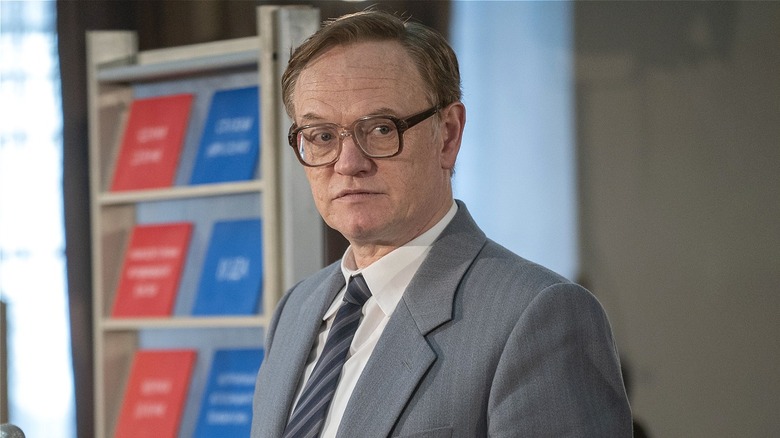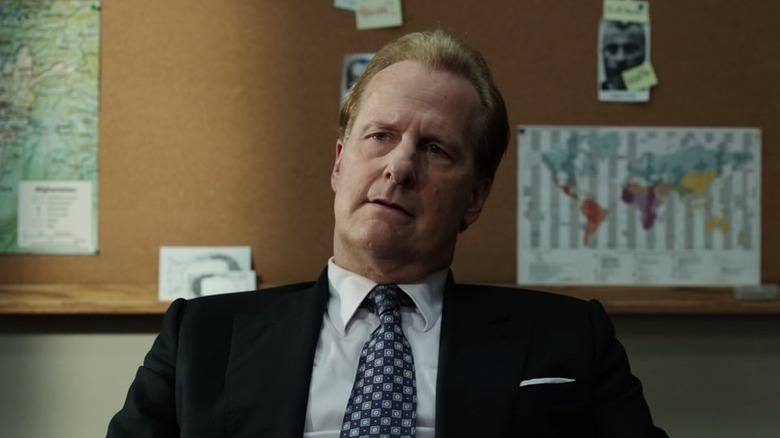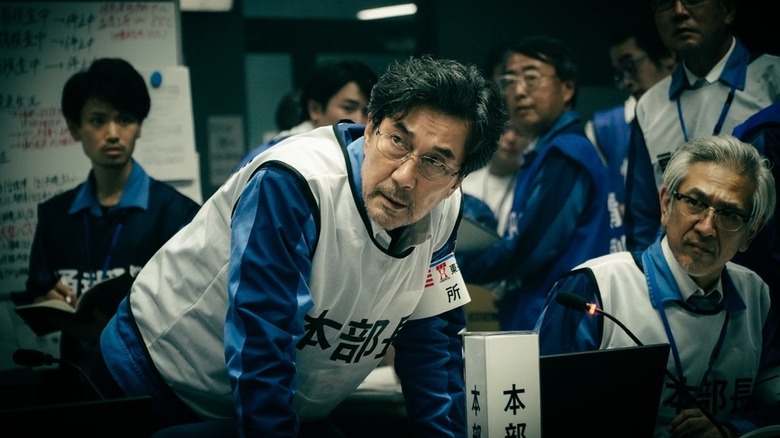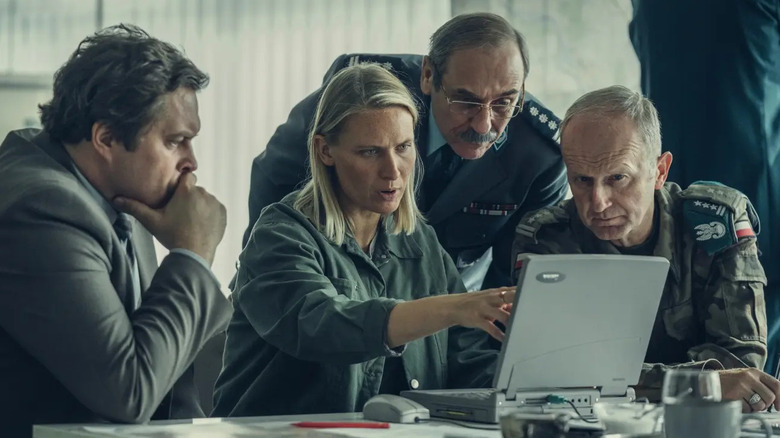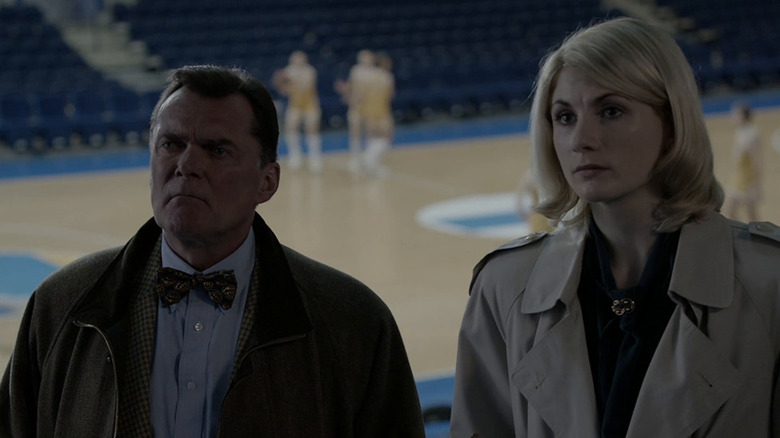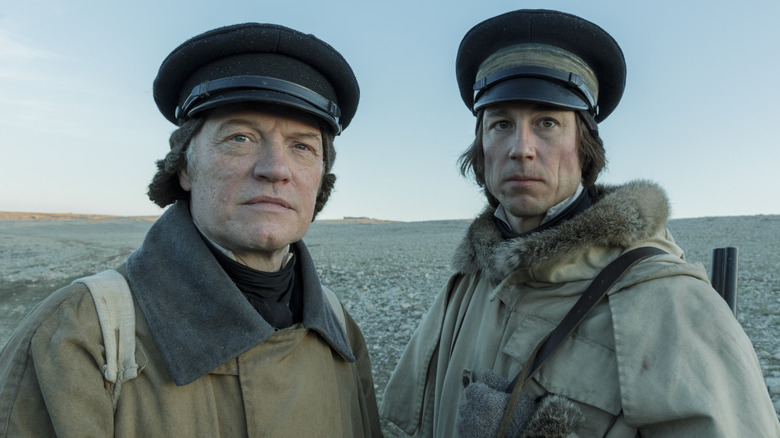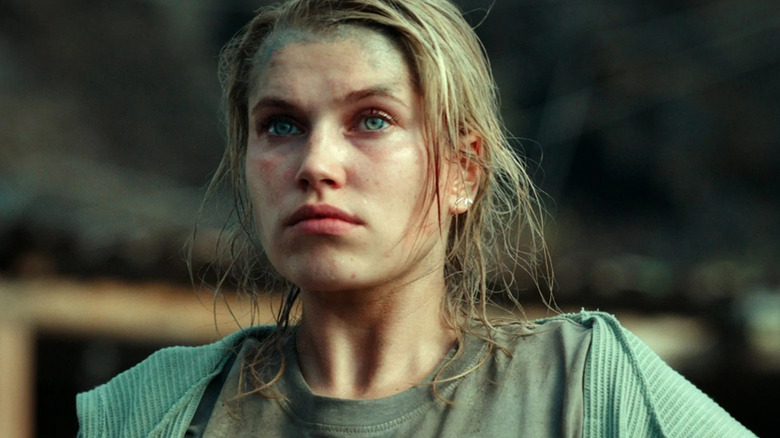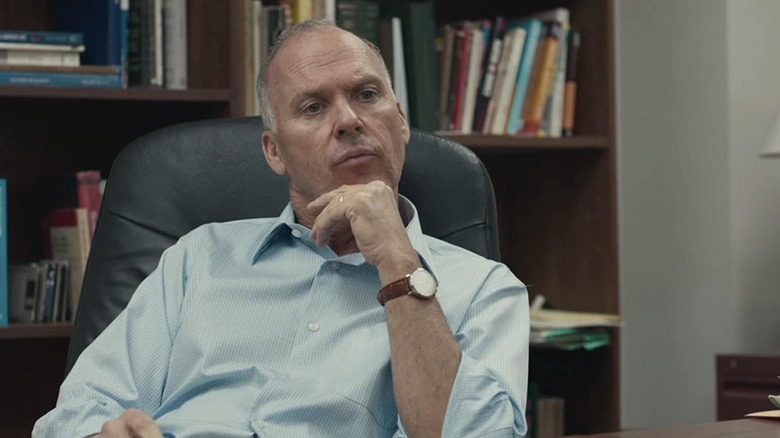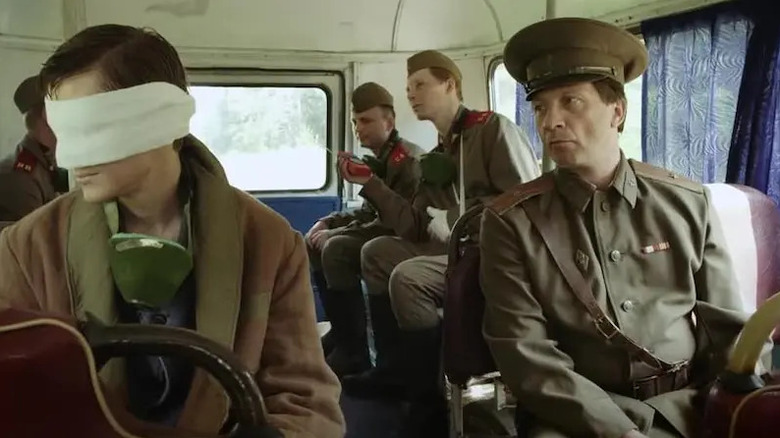The HBO original series “Chernobyl” chronicled the remarkable true story of the titular city’s nuclear meltdown in 1986. But “Chernobyl” is no disaster series — instead it’s a five-episode drama that explores the Soviet government’s role in the disaster and the fallout from their failure. From poorly-planned safety precautions to a lack of oversight and a desire to maintain the illusion of stability, the story takes a hard look at what really happened and who is to blame.
In the series, Jared Harris stars as Valery Legasov, who supervised the initial cleanup of the accident site, while Stellan Skarsgård plays Boris Shcherbina, the man tasked with investigating the cause of the disaster. With the Cold War raging, much of the series emphasizes the government’s attempts to cover up and downplay the disaster for fear of making the Soviet regime appear weak. They also have concerns that their American rivals might take advantage of their vulnerability should the truth be known.
A gripping drama filled with nerve-wracking suspense, “Chernobyl” may have been just five episodes, but it still managed to earn a whole slew of Emmy nominations, taking home the trophy for outstanding limited series. It’s is certainly not the only show of its kind, though, and we’ve found a dozen more that should satisfy you if you loved “Chernobyl.”
The Looming Tower
HBO’s “Chernobyl” chronicles the aftermath of the worst nuclear disaster in history up to that point. It shows how the Soviet government clashed within its own ranks over how to respond, with more concerns about how it might look to the public than with how many lives could be lost. These same themes sit at the heart of Hulu’s “The Looming Tower,” a miniseries that tracks the events leading up to 9/11 — the worst terror attack on American soil — and how the U.S. government’s own action and inaction may have allowed it to happen.
Produced for Apple TV+ and based on a bombshell book, “The Looming Tower” stars Jeff Daniels as FBI counter-terrorism expert John O’Neill, who, in the series’ opening installment, is investigating a terrorist attack on the American Embassy in Nairobi. They discover it was carried out by a little-known organization called Al-Qaeda, who the audience knows will be involved in an attack on New York’s World Trade Center just a few years later.
That looming attack casts a shadow over everything in the series, as we chart O’Neill’s continued frustrations with the investigation, including the CIA’s reticence to share information that could prevent future attacks. While the two agencies squabble, the danger increases — and the audience knows that the stakes are much higher than anyone realizes. Like “Chernobyl,” the Apple TV+ miniseries explores the controversy surrounding a deadly international crisis that could have been prevented.
Waco: The Aftermath
A decade before 9/11, one of the biggest domestic crises took place in America’s heartland, when the FBI raided the compound of David Koresh, a cult-like leader wanted on drug and gun charges. After an armed stand-off between Koresh, his followers — the Branch Davidians — and the FBI, dozens were left dead, including many children and a number of government agents. The miniseries “Waco: The Aftermath,” like “Chernobyl,” retells the fallout of a national crisis and the government’s desperate attempts to cover up their wrongdoing in an effort to escape public scrutiny.
The series begins just after the siege came to a fatal conclusion, with the compound burned to the ground. The Branch Davidians are blamed by the FBI for setting the blaze, while the Davidians themselves insist that it was the FBI who opened fire on them in an unprovoked assault. In the wake of the tragedy, FBI hostage negotiator Gary Noesner (Michael Shannon) laments his choices and is wracked with guilt over whether there’s something else he could have done to negotiate a better outcome. The FBI, meanwhile, will do whatever it takes to lay the blame for the carnage on Koresh and his followers, no matter what the truth might be.
Though controversial for humanizing Koresh and the Branch Davidians a little too much, the more balanced and nuanced look at both sides provides a fresh perspective. Of note, of course, is that “Waco: Aftermath” is a sequel, following from the 2018 miniseries “Waco,” which dramatized the siege itself, but each can be enjoyed entirely separately.
The Hot Zone
Governments must often face scrutiny over their response to a crisis, but it’s not just nuclear disasters and terrorist attacks. As we all know from 2020, issues related to how a nation’s government reacts to a potentially deadly viral outbreak — particularly one that carries a risk of becoming a pandemic — are more common than you’d think. And such viral outbreaks are at the center of “The Hot Zone,” whose first season is focused on a series of incidents that occurred throughout the 1970s and ’80s involving the first cases of the Ebola virus.
Flitting back and forth between different events in different eras, “The Hot Zone” takes an already terrifying real-life scenario and turns it into a suspense-addled thriller series. In 1989, Dr. Nancy Jaxx (Julianna Margulies) theorizes that a case of simian hemorrhagic flu may actually be linked to a virus discovered in Zaire more than a decade earlier. Meanwhile, in 1976, that initial outbreak is being investigated by researcher Wade Carter (Liam Cunningham). There, Carter witnesses firsthand the horrific lengths that local authorities are willing to go to in order to stop the outbreak from spreading. Years later, Wade’s career sits in tatters when Jaxx reaches out to him for help on her latest theories on the virus.
Airing on National Geographic, “The Hot Zone” is a stirring look at how poorly prepared we really are in the face of a devastating viral outbreak. Its second season, meanwhile, stars Daniel Dae-Kim as an FBI agent investigating the 2001 anthrax scare.
The Days
In 1986, the meltdown at Chernobyl was the worst nuclear disaster in the history of the world: Worse than Three Mile Island in 1979, and exponentially worse than Russia’s first major nuclear disaster at Kyshtym in 1957. If you’re looking for a television series that delves into what happened behind the scenes of the only nuclear disaster worse than Chernobyl, watch the miniseries “The Days,” which takes the events of the meltdown at the Fukushima power plant in Japan and dramatizes them for the small screen.
It’s the spring of 2011, and the staff at the Fukushima Daiichi Nuclear Power Plant suddenly find themselves facing a potential calamity as a powerful tsunami approaches, the result of a 9.1 magnitude earthquake off Japan’s shores. The resulting devastation damages the facilities and threatens to pour dangerous levels of radioactive material into the air and surrounding waterways if desperate measures aren’t taken.
Despite the loss of some 20,000 lives from the quake and tsunami, experts agree today that the situation could have been far worse if not for the efforts of the men and women at the Fukushima Daiichi Nuclear Power Plant. “The Days” examines the tireless efforts of those willing to put their own lives on the line to ensure that the resulting fallout didn’t take thousands more lives.
High Water
From “Chernobyl” and “The Days” to “The Looming Tower,” there are plenty of shows about some of the biggest disasters that made international headlines around the world. But one of the little-known and even lesser-remembered disasters to get the TV treatment is the 1997 flood that killed more than 100 people in Poland and the Czech Republic. Tragically, the years since have revealed how government efforts in the wake of the flooding — combined with poor preparation and deficiencies in infrastructure and disaster preparation — were at least partly to blame for the severity of the disaster.
As “High Water” begins, a hydrologist named Jaśmina Tremer (Agnieszka Zulewska) worries about a possible flood in the near future in the town of Wroclaw, Poland. Rising water levels of a nearby river show dangerous signs of an impending disaster, but authorities have more pressing matters. They are preparing for a major event — an official visit from the Pope — and the town doesn’t want to alarm locals with unfounded rumors or paranoid fears of a natural disaster.
Following the lead-up to the disaster and the devastating aftermath, “High Water” never shies away from the grim reality of the situation, much like “Chernobyl.” It places blame on all sides, but also examines the moral questions surrounding disaster mitigation, as authorities faced a stark decision whether to destroy people’s homes to divert flood waters.
The Assets
The Chernobyl nuclear disaster occurred as the Cold War was raging in the mid-1980s. If you want to get a broader view of events of the Cold War beyond Soviet Borders, try “The Assets,” a TV miniseries from 2014. The series is also based on a remarkable true story, this time that of CIA agent Sandra Grimes and her nearly decade-long search for a Soviet mole within her own agency. Like “Chernobyl,” it also stars a renowned British actor, Jodie Whittaker, who divided fans for her portrayal of Doctor Who.
Whittaker stars as Grimes, who, after the death of a colleague, suspects there might be a double agent in the CIA, passing information about American spies to the Soviets. Desperate to hide what they know for fear of tipping off the mole, a secret investigation is assigned to Grimes, who recruits a hand-selected team of her own to look into her fellow agents within the CIA. But when the leaks don’t stop, Grimes comes to one inescapable conclusion: The mole must be even closer to her than she could ever imagine.
A spectacular thriller, “The Assets” is a truly engrossing adaptation of the case of the largest intelligence leak in American history. As dramatic and suspenseful as any fictional spy movie, the fact that it’s based on a true story makes it that much more incredible.
The Terror
“The Terror” is an unusual entry for a list of shows like “Chernobyl.” It’s based on a real event and chronicles the true story of a bitter disaster that took many lives. But it’s also a horror series, taking the infamous tale of the HMS Terror, which was lost at sea on an expedition to the Arctic Circle in 1845, and injecting the supernatural into the story. Dubbed the Lost Franklin Expedition, it involved two ships, including the HMS Erebus, which, along with the Terror, ventured deep into the Canadian Arctic on a mission to locate the legendary trade route known as the Northwest Passage.
In reality, the ships were lost, with wreckage only discovered in 1850 after dozens of searches turned up nothing. But in “The Terror,” we see a fictional account of what might have happened on the ill-fated voyage, and it’s like nothing you’d expect. While charting the vast, unexplored region, the two ships become trapped in ice. Yet, dwindling food rations are the least of their worries when the crews of the two ships find themselves stalked by an unearthly evil.
Following a real-world event is hardly the only reason to watch “The Terror” if you loved “Chernobyl,” of course. The series is also led by “Chernobyl” star Jared Harris, who gives another impressive performance, this time as HMS Terror’s captain, Francis Crozier.
Five Days at Memorial
Back in 2005, Hurricane Katrina — one of the worst storms in the history of the United States — struck New Orleans. The death toll ultimately reached over 1800 souls, while the storm itself left the region a post-apocalyptic nightmare, doing more than $108 billion in damages. Many placed blame on the Bush administration for its slowness in responding to the disaster, while others claim that the region’s large minority population may be why the crisis was downplayed as it ripped apart one of America’s oldest cities.
One of the best shows on Apple TV+, “Five Days at Memorial” is a five-episode miniseries based on a non-fiction book of the same name. It focuses less on the goings-on behind the scenes at a government agency, instead placing its focus on the efforts of first responders who converge on the city’s Memorial Medical Center, led by Dr. Anna Pou (Vera Farmiga). As the title suggests, the miniseries chronicles Pou and her team’s desperate efforts to save lives in the immediate aftermath of the storm, as a loss of power and flooding within the building quickly turns a crisis into a nightmare. As government officials assure the public that all is well at Memorial, Pou and her team face increasingly dangerous situations — and not everyone will make it out alive.
The Railway Men
A deadly incident not widely discussed outside of India, the 1984 Bhopal disaster occurred thanks to a massive toxic gas leak that affected more than half a million people in the vicinity of the Union Carbide India Limited pesticide plant. Decades later, the event formed the basis for the 2023 Netflix original miniseries, “The Railway Men,” a Hindi-language film starring R. Madhavan, Kay Kay Menon, Babil Khan, and Divyenndu. They star as a group of railway workers whose efforts at the Bhopal railway station amid the fatal leak may have saved untold hundreds of lives.
Exceptional performances from a talented cast fuel the riveting story of the Bhopal disaster, told through the eyes of a group of people who seem to be the only ones willing to take the necessary steps to avert further tragedy. While authorities sit on their hands, infrastructure collapses, and death sweeps through the city, there is little hope of winning the fight, but that’s the story of “Railway Men”: Finding hope amid a terrifying ordeal and heroism in the most unlikely places. But it also hammers home the personal toll the disaster takes on those let down by a broken system that is more concerned with profits and efficiency than with the human cost of failure.
La Palma
“La Palma” is the only entry on this list not to be at least inspired by real events. Still, it’s a story that’s thematically very similar to “Chernobyl,” as it follows a disaster that strikes a region completely unprepared for the devastation that it brings. It is, however, inspired by a theoretical weather model known as the Cumbre Vieja Tsunami Hazard, a hypothesis brought forth by a pair of researchers in the early 2000s.
According to the hypothesis, a volcanic eruption on the island of La Palma, Canary Islands, Spain, could cause a megatsunami in the Atlantic Ocean. Theoretically, such a tsunami would threaten not only Spain, but Atlantic-bordering countries like the United States, Canada, the United Kingdom, and Brazil, among others. Though debate has raged for years on the veracity of this hypothesis, the 2024 Norwegian mini-series “La Palma” shows us what could happen if it turned out to be accurate. Focused mostly on the events at the Canary Islands as the volcano erupts, “La Palma” revolves around a group of ordinary people attempting to stay alive while demonstrating how a lack of preparation for such an event can have a global impact.
Dopesick
Michael Keaton might be the best Batman, but he’s also made a name for himself in underrated movie biopics like “The Founder,” about the man who started McDonald’s (or rather about the man who stole it from the two brothers who did). And in 2021, Keaton took his biopics to television, starring in the TV miniseries “Dopesick.” In the Hulu original drama, the actor plays Dr. Fennix, a fictionalized version of a real Tennessee doctor who became a victim of the opioid epidemic before eventually fighting to raise awareness about the dangers of such drugs. As in “Chernobyl,” we see an entire industry fighting tooth and nail to dismiss a grave threat despite mountains of evidence.
Like “Chernobyl,” “Dopesick” explores the crisis from a variety of angles. We meet families whose lives are decimated by opioid addiction and the pharmaceutical companies that spend millions trying to cover it all up. But we also meet the activists like Dr. Fennix, who do everything they can to expose what was really happening to the public and shine a light on a disease that is taking countless lives.
Nominated for a whopping 14 Emmy Awards, “Dopesick” earned Keaton his first Emmy win, for outstanding lead actor in a limited series.
Inseparable
“Chernobyl” isn’t the only TV drama series to cover the Ukrainian nuclear disaster in 1986. More than a decade before the HBO series, there was a Ukrainian-produced series that also told the story, titled “Inseparable.” With less of an emphasis on the actual catastrophe and the government’s response, “Inseparable” digs deeper into the human toll the event took on the region, with a story that unfolds through the lives of ordinary people, telling something of a love story amid the tragedy.
In “Inseparable,” we meet Alya (Mariya Poezzhaeva), a young girl who refuses to leave her hometown of Pripyat in the wake of an evacuation order given following an explosion at the Chernobyl power plant. During the ensuing chaos, she has a chance encounter with a conscript named Pavel (Yuri Borisov), who has been called in to help with the situation. During the crisis, the two find love, but after being separated, they must go to extraordinary lengths to see each other again.
The budding love story takes center stage in “Inseparable,” which makes the four-episode series more of a romantic drama than a biopic or history lesson. Yet set against the backdrop of the worst nuclear disaster in history at the time, it provides a more personal perspective of events seen in HBO’s “Chernobyl,” making it a solid companion series.

